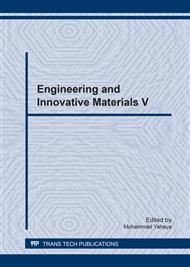p.108
p.113
p.119
p.127
p.133
p.138
p.143
p.148
p.152
The Study of Dendrite Arm Spacing (DAS) on Acoustical of Tin Bronze 20Sn Alloy as Gamelan Bali Materials
Abstract:
Bronze especially tin bronze is mostly used as material of traditional music instrument such as gamelan, cymbals, or bells. Casting process becomes an important process in making gamelan. Solidification is the most important process in the casting. This study is designed to evaluate variant of solidification rate on casting process of conventional bronze (tin bronze) as gamelan material. This study aimed at finding variant of Dendrite Arm Spacing (DAS) on acoustical characteristic of bronze alloy. The alloy of Cu–20Sn is chosen as the composition of tin-bronze because this composition is widely used as the gamelan material. Variant of solidification rate is designed by varying mold temperature and casting temperature. The bronze is melted in crucible furnace until 1050, 1100, 1100oC. Then, the melted material was poured into the mold in 400°C temperature. This study showed that increase of casting temperature influence the decrease of solidification rate which affecting the longer time of solidification. The difference of solidification rate affected on the construction of micro structure and the dendrite (DAS) formed. The size of the dendrite forms affected the mechanical and acustical tin bronze.
Info:
Periodical:
Pages:
133-137
Citation:
Online since:
March 2017
Authors:
Keywords:
Price:
Сopyright:
© 2017 Trans Tech Publications Ltd. All Rights Reserved
Share:
Citation:


